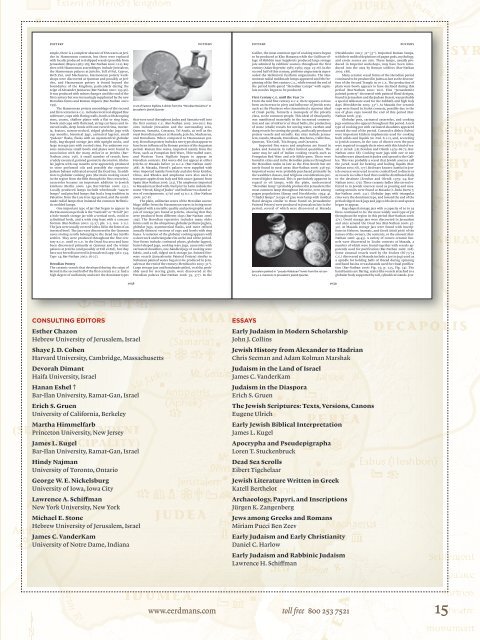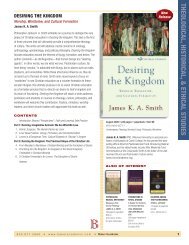Eerdmans
Eerdmans
Eerdmans
- No tags were found...
You also want an ePaper? Increase the reach of your titles
YUMPU automatically turns print PDFs into web optimized ePapers that Google loves.
POTTERY<br />
POTTERY<br />
POTTERY<br />
POTTERY<br />
ample, there is a complete absence of ESA wares at Jericho<br />
in Hasmonean contexts, but these were replaced<br />
with locally produced red-slipped vessels (possibly from<br />
Jerusalem) (Hayes 1985: 183; Bar-Nathan 2002: 121). Key<br />
sites with Hasmonean assemblages include Jerusalem,<br />
the Hasmonean palaces at Jericho, Tell el-Ful, Cypros,<br />
Beth Zur, and Machaerus. Hasmonean pottery workshops<br />
were discovered at Qumran and possibly at Jericho,<br />
and Hasmonean pottery is found beyond the<br />
boundaries of the kingdom, particularly during the<br />
reign of Alexander Jannaeus (Bar-Nathan 2002: 195-96).<br />
It was produced with minor changes until the end of the<br />
first century but was increasingly supplanted by the new<br />
Herodian forms and Roman imports (Bar-Nathan 2002:<br />
199).<br />
The Hasmonean pottery assemblage of the second<br />
and first centuries b.c.e. includes local red-slipped fine<br />
tableware, cups with flaring walls, bowls with drooping<br />
rims, coarse, shallow plates with a flat or ring base,<br />
bowls and cups with flattened, string-cut bases and incurved<br />
walls, deep bowls with out-curved rims, mortaria,<br />
kraters, narrow-necked, ridged globular jugs with<br />
cup mouths, biconical jugs, carinated lagynoi, small<br />
“Judean” flasks, flasks with an asymmetrical globular<br />
body, bag-shaped storage jars with upright necks, and<br />
large storage jars with everted rims. For unknown reasons<br />
numerous small bowls and plates were found in<br />
association with the many mikva}ot at Jericho (Bar-<br />
Nathan 2002: 196). A small number of vessels have<br />
crudely executed, painted geometric decoration. Globular<br />
juglets with cup mouths were apparently produced<br />
to store perfumed oils and possibly the expensive<br />
Judean balsam cultivated around the Dead Sea. In addition<br />
to globular cooking pots (the main cooking vessel<br />
in the region from the fifth through the first centuries),<br />
casseroles became an important addition to Jewish<br />
kitchens (Berlin 2006: 140; Bar-Nathan 2006: 151).<br />
Locally produced lamps include wheelmade “saucer<br />
lamps” and pinched lamps that had a long tradition in<br />
Palestine from the Late Iron Age period, and the moldmade<br />
radial lamps that imitated the common Hellenistic<br />
molded lamps.<br />
One important type of jar that began to appear in<br />
the Hasmonean periods is the “Genizah” or “Scroll” jar:<br />
a hole-mouth storage jar with a vertical neck, ovoid or<br />
cylindrical body, and a wide ring base with a concave<br />
bottom (Bar-Nathan 2002: 23-27; pls. 1-2, nos. 2-11).<br />
The jars were usually covered with a lid in the form of an<br />
inverted bowl. The jars were discovered in the Qumran<br />
caves storing scrolls belonging to the Dead Sea Scrolls<br />
archive. They were produced throughout the first century<br />
b.c.e. until 70 c.e. in the Dead Sea area and have<br />
been discovered primarily at Qumran and the winter<br />
palaces at Jericho (and possibly at Tell el-Ful), but they<br />
have not been discovered in Jerusalem (Lapp 1961: 154,<br />
Type 14; Bar-Nathan 2002: 26-27).<br />
Herodian Pottery<br />
The ceramic vessels that developed during the reign of<br />
Herod in the second half of the first century b.c.e. had a<br />
high degree of uniformity and were the dominant types<br />
A set of Eastern Sigillata A dishes from the “Herodian Residence” in<br />
Jerusalem’s Jewish Quarter<br />
that were used throughout Judea and Samaria well into<br />
the first century c.e. (Bar-Nathan 2002: 200-201). Key<br />
sites include Jerusalem and the surrounding area,<br />
Qumran, Samaria, Caesarea, Tel Anafa, as well as the<br />
royal Herodian palaces at Masada, Jericho, Machaerus,<br />
and Herodium. When compared to Hasmonean pottery,<br />
Herodian pottery includes new types that appear to<br />
have been influenced by Roman pottery of the Augustan<br />
period. Roman fine wares, imported mainly from the<br />
West, such as Pompeian Red Ware, Thin-walled ware,<br />
and Western Terra Sigillata began to appear in<br />
Herodian contexts. ESA wares did not appear at either<br />
Jericho or Masada before 30 b.c.e. (Bar-Nathan 2006:<br />
368). At Masada, Herod’s palaces were supplied with<br />
wine imported mainly from Italy and also from Knidos,<br />
Chios, and Rhodes and amphorae were also used to<br />
transport apples from Italy and fish sauce (garum) from<br />
Spain (Bar-Nathan 2006: 313). The amphorae imported<br />
to Masada inscribed with tituli picti in Latin include the<br />
name “Herod, King of Judea” and indicate two dated series<br />
of consignments: 27/26 and 19 b.c.e. (Bar-Nathan<br />
2006: 307-8).<br />
The plain, utilitarian wares of the Herodian assemblage<br />
differ from the Hasmonean wares in being more<br />
levigated with a metallic quality and petrographic analysis<br />
of storage jars found at Jericho, showing that they<br />
were produced from different clays (Bar-Nathan 2006:<br />
199). The Herodian repertoire includes many older<br />
forms such as the ubiquitous globular perfume juglets,<br />
globular jugs, asymmetrical flasks, and more refined<br />
(usually thinner) versions of cups and bowls with ring<br />
bases. A variation of the globular cooking appears with<br />
a short neck and triangular rim at the end of the period.<br />
New forms include: carinated plates, globular lagynoi,<br />
barrel-shaped jugs, cooking ware jugs, casseroles with<br />
carinated shoulders, one-handled jugs of cooking ware<br />
fabric, and a tall, ridged neck storage jar. Painted fineware<br />
vessels (Jerusalemite Painted Pottery) similar to<br />
Nabatean painted wares began to be produced in Jerusalem<br />
at the end of the century (Hershkovitz 2003: 31*).<br />
Large storage jars and handmade pithoi, or dolia, probably<br />
used for storing grain, were discovered at the<br />
Herodian palaces (Bar-Nathan 2006: 39, 377). In the<br />
Galilee, the most common type of cooking wares began<br />
to be produced at Kfar Hananya while the Galilean village<br />
of Shikhin near Sepphoris produced large storage<br />
jars admired by rabbinic sources throughout the first<br />
century (Adan-Bayewitz 1987; 1989; 1993: 23-26). In the<br />
second half of this century, piriform unguentaria superseded<br />
the Hellenistic fusiform unguentaria. The Hasmonean<br />
radial moldmade lamps appeared until the beginning<br />
of the first century c.e., while toward the end of<br />
the period knife-pared “Herodian Lamps” with saptulate<br />
nozzles began to be produced.<br />
First Century c.e. until the Year 70<br />
From the mid first century b.c.e. there appears to have<br />
been an increase in piety and influence of Jewish sects<br />
such as the Pharisees who transmitted a rigorous ideal<br />
of ritual purity, formerly a monopoly of the priestly<br />
class, to the common people. This ideal of ritual purity<br />
was manifested materially in the increased construction<br />
and use of mikva}ot or ritual baths, the production<br />
of stone (chalk) vessels for storing water, earthen and<br />
dung vessels for storing dry goods, and locally produced<br />
pottery vessels and utensils. Key sites include Jerusalem,<br />
Gamla, Masada, Herodium, Macherus, Callirrhoe,<br />
Qumran, {Ein Gedi, {Ein Boqeq, and Caesarea.<br />
Imported fine wares and amphorae are found in<br />
Judea and Samaria in rather limited quantities. The<br />
same may be said of Italian cooking vessels such as<br />
Pompeian Red Ware and orlo bifido pans. These were<br />
found in cities and in the Herodian palaces throughout<br />
the Herodian realm as late as the First Revolt but are<br />
rarely found in rural areas (Bar-Nathan 2006: 358-59).<br />
Imported wares were probably purchased primarily by<br />
the wealthier classes, and religious considerations prevented<br />
higher demand. This is particularly apparent in<br />
regard to oil lamps, with the plain, undecorated<br />
“Herodian lamp” (probably produced in Jerusalem) the<br />
most common lamp throughout Palestine, even among<br />
pagan populations (Barag and Hershkovitz 1994: 4).<br />
“Citadel lamps” (a type of gray ware lamp with molded<br />
floral designs similar to those found on Jerusalemite<br />
Painted Pottery) were produced in Jerusalem late in the<br />
period, several of which were discovered at Masada<br />
Jerusalem painted or “pseudo-Nabatean” bowls from the 1st-century-c.e.<br />
mansions in Jerusalem’s Jewish Quarter.<br />
(Hershkovitz 2003: 32*-33*). Imported Roman lamps,<br />
with their molded depictions of pagan gods, mythology,<br />
and erotic scenes are rare. These lamps, usually produced<br />
in Imperial workshops, may have been introduced<br />
into the area by Roman soldiers (Bar-Nathan<br />
2002: 188).<br />
Many ceramic vessel forms of the Herodian period<br />
continued to be produced in Judea as late as the destruction<br />
of the Second Temple in 70 c.e. The production of<br />
plain ware bowls appears to have declined during this<br />
period (Bar-Nathan 2002: 202). Fine “Jerusalemite<br />
painted pottery” decorated with painted floral designs,<br />
found in Jerusalem and the Judean Desert, was probably<br />
a special tableware used for the Sabbath and high holy<br />
days (Hershkovitz 2003: 33*). At Masada few ceramic<br />
cups were found in Zealot contexts, possibly due to the<br />
use of glass cups toward the end of this period (Bar-<br />
Nathan 2006: 374).<br />
Globular pots, carinated casseroles, and cooking<br />
jugs continued to appear throughout this period. A new<br />
type of cooking pot with carinated shoulders appeared<br />
toward the end of the period. Casseroles dishes (kdera)<br />
were important kitchen implements used for cooking<br />
both solids and liquids (m. Ned. 6:1-2), and, according<br />
to Jewish sources, in the case of divorce even the poor<br />
were required to supply their wives with this kind of vessel<br />
(t. Ketub. 5:8; Zevulun and Olenik 1979: 68-71; Bar-<br />
Nathan 2002: 68). Cooking ware jugs with one or two<br />
handles were abundant in Judea and spread to the Galilee.<br />
This was probably a vessel that Jewish sources call<br />
the yorah, used for heating and boiling liquids (Bar-<br />
Nathan 2002: 68, 177). Red ware kraters (tamkui in Jewish<br />
sources) were used to serve cooked food to diners or<br />
as vessels to collect food that could be distributed daily<br />
to the destitute (Zevulun and Olenik 1979: 24; Bar-<br />
Nathan 2002: 179). Three ceramic ladles (the tarvad referred<br />
to in Jewish sources) used as pouring and measuring<br />
utensils were found at Masada (t. Baba Batra 7;<br />
Bar-Nathan 2006: 231). Globular jugs with triangular<br />
rims were the dominant type, and toward the end of the<br />
period ridged-neck jugs and jugs with sieves and spouts<br />
began to appear.<br />
Bag-shaped storage jars with a capacity of 20 to 29<br />
liters continued to be the most widely used type of jar<br />
throughout the region in this period (Bar-Nathan 2006:<br />
371). Ovoid storage jars were discovered in Jerusalem<br />
and sites around the Dead Sea (Bar-Nathan 2006: 47-<br />
50). At Masada storage jars were found with inscriptions<br />
in Hebrew, Aramaic, and Greek (tituli picti) of the<br />
names of the owners, the contents, or the amount (Bar-<br />
Nathan 2006: 44-45). A variety of convex ceramic funnels<br />
were discovered in Zealot contexts at Masada, a<br />
number of which were found together with vessels apparently<br />
used for purification (Bar-Nathan 2006: 228).<br />
Some unusual vessels used by the Zealots (66-73/74<br />
c.e.) discovered at Masada include a jar (or jug) used as<br />
a spindle for holding balls of thread during spinning<br />
and hand basins or washstands used for ritual purification<br />
(Bar-Nathan 2006: Fig. 75; p. 235, Fig. 74). The<br />
hand basins are flaring, crater-like vessels attached to a<br />
globular body supported by tall, cylindrical stands. Jew-<br />
1058<br />
1059<br />
Consulting Editors<br />
Esther Chazon<br />
Hebrew University of Jerusalem, Israel<br />
Shaye J. D. Cohen<br />
Harvard University, Cambridge, Massachusetts<br />
Devorah Dimant<br />
Haifa University, Israel<br />
Hanan Eshel †<br />
Bar-Ilan University, Ramat-Gan, Israel<br />
Erich S. Gruen<br />
University of California, Berkeley<br />
Martha Himmelfarb<br />
Princeton University, New Jersey<br />
James L. Kugel<br />
Bar-Ilan University, Ramat-Gan, Israel<br />
Hindy Najman<br />
University of Toronto, Ontario<br />
George W. E. Nickelsburg<br />
University of Iowa, Iowa City<br />
Lawrence A. Schiffman<br />
New York University, New York<br />
Michael E. Stone<br />
Hebrew University of Jerusalem, Israel<br />
James C. VanderKam<br />
University of Notre Dame, Indiana<br />
ESSAYS<br />
Early Judaism in Modern Scholarship<br />
John J. Collins<br />
Jewish History from Alexander to Hadrian<br />
Chris Seeman and Adam Kolman Marshak<br />
Judaism in the Land of Israel<br />
James C. VanderKam<br />
Judaism in the Diaspora<br />
Erich S. Gruen<br />
The Jewish Scriptures: Texts, Versions, Canons<br />
Eugene Ulrich<br />
Early Jewish Biblical Interpretation<br />
James L. Kugel<br />
Apocrypha and Pseudepigrapha<br />
Loren T. Stuckenbruck<br />
Dead Sea Scrolls<br />
Eibert Tigchelaar<br />
Jewish Literature Written in Greek<br />
Katell Berthelot<br />
Archaeology, Papyri, and Inscriptions<br />
Jürgen K. Zangenberg<br />
Jews among Greeks and Romans<br />
Miriam Pucci Ben Zeev<br />
Early Judaism and Early Christianity<br />
Daniel C. Harlow<br />
Early Judaism and Rabbinic Judaism<br />
Lawrence H. Schiffman<br />
www.eerdmans.com toll free 800 253 7521 15













